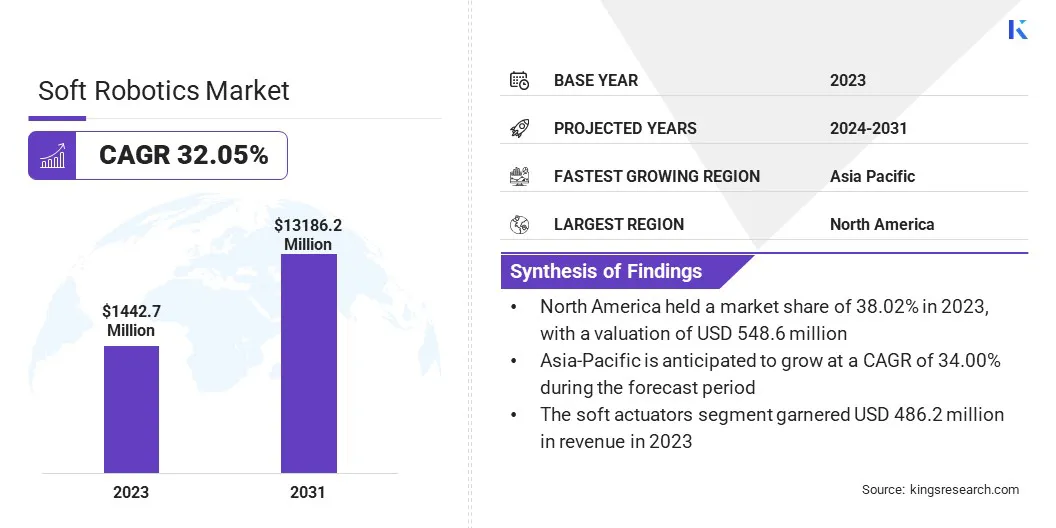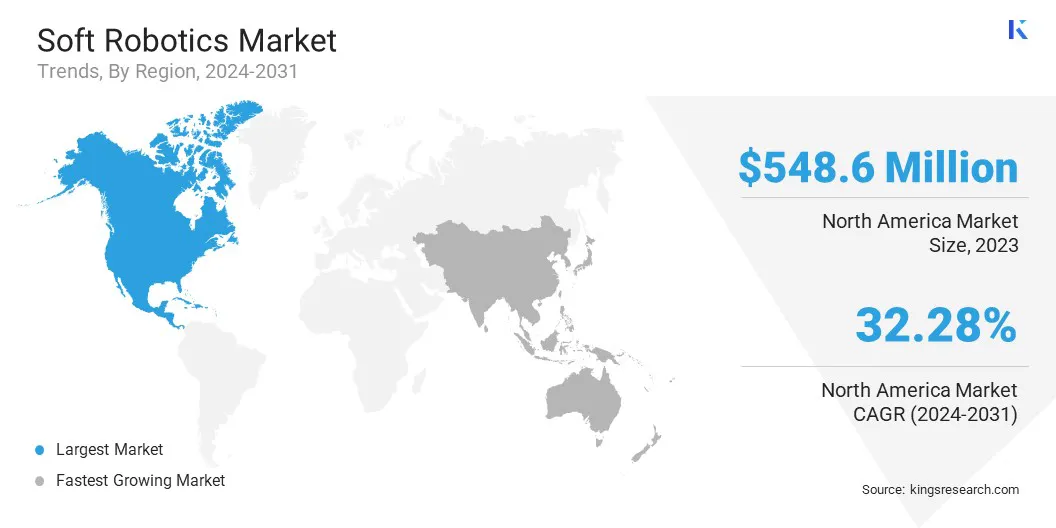Soft Robotics Market Size
Global Soft Robotics Market size was recorded at USD 1,442.7 million in 2023, which is estimated to be valued at USD 1,883.4 million in 2024 and is projected to reach USD 13,186.2 million by 2031, growing at a CAGR of 32.05% from 2024 to 2031.
The market is seeing significant growth, largely driven by advancements in flexible materials and adaptive technologies. These innovations are broadening the applications of soft robotics, enhancing efficiency and automation across various industries. The market is expanding as businesses recognize the potential of soft robotics to offer improved safety, versatility, and operational effectiveness.
In the scope of work, the report includes products offered by companies such as Oxipital AI, RightHand Robotics, Inc., Ekso Bionics, Lifeward, Inc., Yaskawa Electric Corporation, Bioservo, Festo India Private Limited, ROAM ROBOTICS, ABB, Omron Corporation, and others.
The soft robotics market is witnessing rapid expansion, mainly due to the increasing prevalence of chronic diseases such as urological, gynecological, and orthopedic conditions, which demand advanced, adaptable surgical solutions.
- According to the latest World Health Organization (WHO) report, non-communicable diseases (NCDs), including like cardiovascular disease, cancer, diabetes, and chronic respiratory diseases account for approximately 74% of global deaths, totaling 41 million fatalities annually.
This rising burden underscores the need for soft robotics in medical applications, where their flexibility and precision enhance surgical outcomes and patient care.
- In December 2023, researchers from China’s Beihang University unveiled a breakthrough, featuring a soft robotic arm that mimics octopus’ movements. This innovation promises to advance human-robot interaction and has the potential to revolutionize medical, elderly care, and delicate underwater operations.
These advancements in soft robotics, coupled with the growing need for sophisticated medical solutions due to the rising prevalence of chronic diseases, are significantly propelling market growth.
Soft robotics is an emerging field within robotics focused on designing robots made from flexible, soft materials that mimic the movement and adaptability of biological systems. Unlike traditional rigid robots, soft robots use materials such as silicone, elastomers, and other polymers to achieve greater flexibility and resilience.
This allows them to safely interact with humans and handle delicate objects, making them ideal for applications in healthcare, wearable devices, and industries requiring gentle manipulation. The versatility of soft robotics enables their use in dynamic, unpredictable environments, with their adaptive nature fostering innovation across sectors such as medical care, agriculture, and manufacturing.

Analyst’s Review
The soft robotics market is experiencing robust growth, mainly attributed to significant investments in technological advancements, enabling the development of highly specialized solutions. This focus on innovation is boosting demand across various industries, including healthcare, manufacturing, and logistics.
- In February 2024, RightHand Robotics, a leader in autonomous AI-driven robotic picking solutions, secured a multi-year agreement with Staples Inc., a major workspace products provider. This partnership allows Staples to implement the RightPick system for automated order fulfillment, enhancing service levels and achieving Next-Day Delivery for over 98% of the U.S. market.
- In December 2023, ReWalk Robotics, Ltd., a leader in mobility and rehabilitation technologies, successfully demonstrated a proof-of-concept for a next-generation exoskeleton, showcasing the potential of soft robotics in improving mobility for individuals with neurological conditions.
These developments highlight the growing importance of innovation and strategic partnerships in reshaping the landscape of the market.
Soft Robotics Market Growth Factors
The increasing demand for soft robotics in healthcare and rehabilitation is augmenting market growth, as these technologies provide safer and more effective solutions for patient care. Soft robotic devices, such as wearable exoskeletons and robotic gloves, are designed to assist patients with mobility issues, physical therapy, and post-surgery recovery.
Their flexibility and adaptability facilitate more natural, comfortable movement than rigid robotic systems, thereby reducing injury risk and enhancing patient comfort. Healthcare providers are increasingly integrating these technologies into treatment plans, leading to a surge in demand and stimulating soft robotics market growth.
- In January 2024, Chinese scientists developed a robot utilizing a lab-grown human brain organoid. This "brain on a chip" system combines cells with a computer chip, enabling the AI-powered robot to autonomously move, grab objects, and avoid obstacles. Created from stem cells, the brain exhibits human-like intelligence and presents opportunities for breakthroughs in repairing cerebral cortex damage and treating neurological disorders.
A key challenge impeding the development of the market is the high cost associated with development and production due to the complex materials and advanced technologies required. Additionally, limited durability and performance issues in real-world industrial applications hinder widespread adoption. Key players are addressing these challenges by investing in research and development to improve material science, making soft robotics more cost-effective and durable.
Companies are focusing on creating scalable manufacturing processes, such as using 3D printing and advanced polymers, to lower production costs. Collaborations between industry and research institutions are enhancing the robustness and reliability of soft robots, ensuring their performance in demanding environments. Strategic partnerships and government-backed initiatives are further fostering innovation, supporting market expansion.
Soft Robotics Market Trends
Advancement in materials science, especially in soft polymers and smart materials, is emerging as a notable trend in the soft robotics market. These innovative materials offer greater durability, flexibility, and adaptability, allowing soft robotic systems to perform complex tasks with improved efficiency and reliability.
Soft polymers provide elasticity required for robots to mimic biological movements, while smart materials enable responsiveness to environmental stimuli, including temperature or pressure changes. This combination of strength and adaptability broadens applications across healthcare and industrial automation, enabling soft robots to withstand harsher conditions and more demanding tasks, thus fueling market growth.
- In January 2023, the Smart Polymer Materials Group, led by Prof. CHEN Tao at the Ningbo Institute of Materials Technology and Engineering, teamed up with Prof. ZHENG Yinfei from Zhejiang University to develop a hydrogel-based soft robot. This robot features adaptive deformation capabilities that allow it to navigate diverse natural terrains effectively.
The integration of AI and machine learning into soft robotics is propelling market expansion by enabling these systems to perform more complex tasks across diverse industries. AI enhances the ability of soft robots to make real-time decisions and adapt to changing environments, which is essential in sectors such as healthcare, manufacturing, and logistics.
This added functionality increases their appeal to businesses looking for advanced solutions to boost productivity, reduce errors, and streamline operations. The growing adoption of AI-powered soft robots is fueling market growth, supported by expanding applications and increasing investments that foster further innovation in the industry.
Segmentation Analysis
The global market has been segmented based on type, end use, and geography.
By Type
Based on type, the market has been categorized into soft actuators, soft grippers, control systems, sensors, and power sources. The soft actuators segment garnered the highest revenue of USD 486.2 million in 2023.
Soft actuators, made from flexible materials such as elastomers and polymers, allow for safer interactions with humans and delicate objects, making them ideal for use in healthcare, wearable robotics, and industrial automation. Their ability to mimic natural muscle movements offers enhanced precision and control, significantly improving functionality in robotic systems.
Industries such as healthcare are leveraging soft actuators in rehabilitation and assistive devices, while the manufacturing sector employs them for tasks requiring high dexterity. This increasing demand across multiple industries is expected to fuel segmental growth though the projection period.
By End Use
Based on end use, the market has been categorized into consumer electronics, healthcare & medical devices, industrial automation, food & agriculture, and others. The industrial automation segment captured the largest market share of 35.55% in 2023. This growth is largely attributed to the growing need for more flexible and adaptive robotic solutions in manufacturing and logistics.
Soft robotics, particularly in automation, offers enhanced dexterity, enabling machines to handle delicate tasks and varied materials with minimal risk of damage. Industries such as electronics, food processing, and packaging are increasingly adopting soft robots to improve operational efficiency and reduce labor costs.
- In March 2023, researchers at the Singapore University of Technology and Design, with support from A*STAR’s National Robotics Programme, developed a reconfigurable workspace soft (RWS) robotic gripper, designed to improve efficiency in food assembly operations.
The ability of soft robots to operate safely alongside humans in collaborative environments is propelling their use in automated systems, thereby stimulating segemental expansion.
Soft Robotics Market Regional Analysis
Based on region, the global market has been classified into North America, Europe, Asia-Pacific, MEA, and Latin America.

North America soft robotics market accounted for the largest share of 38.02% in 2023, with a valuation of USD 548.6 million. The region's strong emphasis on innovation, coupled with high demand from industries such as healthcare, manufacturing, and logistics, is fueling regional market expansion. Major players in North America are actively developing and deploying soft robotics solutions to enhance operational efficiency, improve safety, and address labor shortages.
Additionally, the presence of leading research institutions and tech hubs in the U.S. and Canada is accelerating advancements in soft robotics technologies. Government initiatives and funding for research and development further support domestic market growth.
Asia-Pacific soft robotics market is anticipated to witness rapid growth, recording a robust CAGR of 34.00% over the forecast period. This growth is attributed to advancements in industrialization and automation across sectors such as healthcare, manufacturing, and logistics.
- In September 2022, a Chinese research team developed a shape-shifting micro-robot, powered by magnetic force that can navigate the human body to treat cardiovascular diseases and other health conditions
Such innovations, supported by government initiatives and technological advancements, are contributing significantly to the progress of the Asia-Pacific market.
Competitive Landscape
The global soft robotics market report will provide valuable insight with an emphasis on the fragmented nature of the industry. Prominent players are focusing on several key business strategies such as partnerships, mergers and acquisitions, product innovations, and joint ventures to expand their product portfolio and increase their market shares across different regions.
Companies are implementing impactful strategic initiatives, such as expanding services, investing in research and development (R&D), establishing new service delivery centers, and optimizing their service delivery processes, which are likely to create new opportunities for market growth.
List of Key Companies in Soft Robotics Market
- Oxipital AI
- RightHand Robotics, Inc.
- Ekso Bionics
- Lifeward, Inc.
- Yaskawa Electric Corporation
- Bioservo
- Festo India Private Limited
- ROAM ROBOTICS
- ABB
- Omron Corporation
Key Industry Developments
- February 2024 (Acquisition): Tompkins Solutions, a leading firm in supply chain consulting and material handling integration, announced a strategic partnership with Soft Robotics, a top provider of innovative robotic automation solutions. This collaboration aims to deploy advanced AI-powered robotics to enhance global logistics operations, addressing ongoing supply chain challenges and improving order fulfillment efficiency.
- April 2024 (Acquisition): Khalifa University of Science and Technology and Silal entered into an agreement to establish a joint Centre of Excellence in Agri-Robotics and Automation. This partnership seeks to leverage advancements in robotics and automation to revolutionize the agriculture sector in the UAE and beyond.
The global soft robotics market is segmented as:
By Type
- Soft Actuators
- Soft Grippers
- Control Systems
- Sensors
- Power Sources
By End Use
- Consumer Electronics
- Healthcare & Medical Devices
- Industrial Automation
- Food & Agriculture
- Others
By Region
- North America
- Europe
- France
- UK.
- Spain
- Germany
- Italy
- Russia
- Rest of Europe
- Asia-Pacific
- China
- Japan
- India
- South Korea
- Rest of Asia-Pacific
- Middle East & Africa
- GCC
- North Africa
- South Africa
- Rest of Middle East & Africa
- Latin America
- Brazil
- Argentina
- Rest of Latin America


